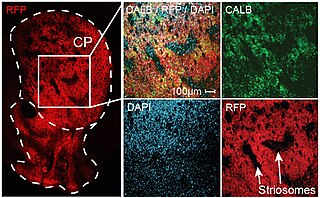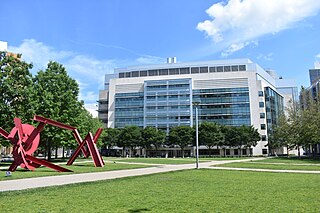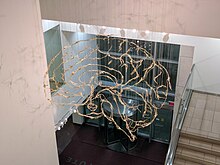
Patrick Joseph McGovern Jr. was an American businessman, and chairman and founder of International Data Group (IDG), a company with subsidiaries in technology publishing, research, event management and venture capital.

The Picower Institute for Learning and Memory is, along with the McGovern Institute for Brain Research and the Department of Brain and Cognitive Sciences, one of the three neuroscience groups at MIT. The institute is focused on studying all aspects of learning and memory; specifically, it has received over US$50 million to study Alzheimer's, schizophrenia and similar diseases.
John Gabrieli is a neuroscientist at MIT, and an Investigator at the McGovern Institute for Brain Research. He is the Grover Hermann Professor of Health Sciences and Technology, a faculty member in the department of Brain and Cognitive Sciences and director of the Athinoula A. Martinos Imaging Center, part of the McGovern Institute. Gabrieli is an expert on the brain mechanisms of human cognition, including memory, thought and emotion. His work includes neuroimaging studies on healthy adults and children as well as clinical patients with many different brain disorders, including schizophrenia, depression, Alzheimer's disease, autism and dyslexia.
The Gruber Prize in Neuroscience, established in 2004, is one of three international awards worth US$500,000 made by the Gruber Foundation, a non-profit organization based in Yale University in New Haven, Connecticut.

Cornelia Isabella "Cori" Bargmann is an American neurobiologist. She is known for her work on the genetic and neural circuit mechanisms of behavior using C. elegans, particularly the mechanisms of olfaction in the worm. She has been elected to the National Academy of Sciences and had been a Howard Hughes Medical Institute investigator at UCSF and then Rockefeller University from 1995 to 2016. She was the Head of Science at the Chan Zuckerberg Initiative from 2016 to 2022. In 2012 she was awarded the $1 million Kavli Prize, and in 2013 the $3 million Breakthrough Prize in Life Sciences.

Earl Keith Miller is a cognitive neuroscientist whose research focuses on neural mechanisms of cognitive, or executive, control. Earl K. Miller is the Picower Professor of Neuroscience with the Picower Institute for Learning and Memory and the Department of Brain and Cognitive Sciences at Massachusetts Institute of Technology. He is the Chief Scientist and co-founder of SplitSage. He is a co-founder of Neuroblox.

Ann Martin Graybiel is an Institute Professor and a faculty member in the Department of Brain and Cognitive Sciences at the Massachusetts Institute of Technology. She is also an investigator at the McGovern Institute for Brain Research. She is an expert on the basal ganglia and the neurophysiology of habit formation, implicit learning, and her work is relevant to Parkinson's disease, Huntington's disease, obsessive–compulsive disorder, substance abuse and other disorders that affect the basal ganglia.

The striosomes are one of two complementary chemical compartments within the striatum that can be visualized by staining for immunocytochemical markers such as mu opioid receptors, acetylcholinesterase, enkephalin, substance P, limbic system-associated membrane protein (LAMP), AMPA receptor subunit 1 (GluR1), dopamine receptor subunits, and calcium binding proteins. Striosomal abnormalities have been associated with neurological disorders, such as mood dysfunction in Huntington's disease, though their precise function remains unknown. Recently studies have identified the presence of "exo-patch" neurons that are biochemically and genetically the same as striosomal neurons, but reside in the matrix compartment. This study also characterized the different input and output connections of the striosome and matrix compartments, revealing that both regions have direct inputs to dopamine neurons. The authors also revealed unique inputs to the striosome from subcortical limbic structures like the amygdala and bed nucleus of the stria terminalis.

The Koch Institute for Integrative Cancer Research at MIT is a cancer research center affiliated with the Massachusetts Institute of Technology (MIT) located in Cambridge, Massachusetts, United States. The institute is one of seven National Cancer Institute-designated basic laboratory cancer centers in the United States.
Robert Desimone is an American neuroscientist who currently serves as the director of the McGovern Institute for Brain Research and the Doris and Don Berkey Professor of Neuroscience at the Massachusetts Institute of Technology.

Edward S. Boyden is an American neuroscientist at MIT. He is the Y. Eva Tan Professor in Neurotechnology, a faculty member in the MIT Media Lab and an associate member of the McGovern Institute for Brain Research. In 2018 he was named a Howard Hughes Medical Institute Investigator. He is recognized for his work on optogenetics. In this technology, a light-sensitive ion channel such as channelrhodopsin-2 is genetically expressed in neurons, allowing neuronal activity to be controlled by light. There were early efforts to achieve targeted optical control dating back to 2002 that did not involve a directly light-activated ion channel, but it was the method based on directly light-activated channels from microbes, such as channelrhodopsin, emerging in 2005 that turned out to be broadly useful. Optogenetics in this way has been widely adopted by neuroscientists as a research tool, and it is also thought to have potential therapeutic applications. Boyden joined the MIT faculty in 2007, and continues to develop new optogenetic tools as well as other technologies for the manipulation of brain activity. Previously, Boyden received degrees in electrical engineering, computer science, and physics from MIT. During high school, Boyden attended the Texas Academy of Mathematics and Science.
Martha Constantine-Paton is a neuroscientist at the Massachusetts Institute of Technology. She is a member of the McGovern Institute for Brain Research and a professor in the Department of Brain and Cognitive Sciences.
Michale Sean Fee is an American neuroscientist who works on the neural mechanisms of sequence generation and learning. Michale Fee is faculty in the Department of Brain and Cognitive Sciences at the Massachusetts Institute of Technology, and an Investigator in the McGovern Institute for Brain Research. His laboratory studies how songbirds generate and learn complex vocal sequences.
Lore Harp McGovern is an American entrepreneur and philanthropist based in California. She co-founded Vector Graphic, one of the earliest personal computing companies, in 1976. She served as the company's CEO and president, took it public, and saw an annual revenue of $36 million before she left the company in 1984.

Guoping Feng is a Chinese-American neuroscientist. He is the Poitras Professor of Neuroscience at the McGovern Institute for Brain Research in the Department of Brain and Cognitive Sciences at MIT and member of the Stanley Center for Psychiatric Research at Broad Institute. He is most notable for studying the synaptic mechanisms underlying psychiatric disease. In addition to developing many genetic-based imaging tools for the study of molecular mechanisms in the brain, he has generated and characterized rodent models of obsessive-compulsive disorder, autism spectrum disorders, and schizophrenia. Feng has also shown that some autism-like behaviors can be corrected in adult mice by manipulating the expression of the SHANK3 gene.

Wendy Suzuki is an American neuroscientist. She is a professor at the New York University Center for Neural Science. She is the author of Healthy Brain, Happy Life: A Personal Program to Activate Your Brain and Do Everything Better. Since September 1, 2022, she has served as Dean of the New York University College of Arts & Science.

The Department of Brain and Cognitive Sciences at the Massachusetts Institute of Technology, Cambridge, Massachusetts, United States, engages in fundamental research in the areas of brain and neural systems, and cognitive processes. The department is within the School of Science at the MIT and began initially as the Department of Psychology founded by the psychologist Hans-Lukas Teuber in 1964. In 1986 the MIT Department of Psychology merged with the Whittaker College integrating Psychology and Neuroscience research to form the Department of Brain and Cognitive Sciences.
Elly Nedivi is an American neuroscientist. She is a professor of brain and cognitive sciences at the Picower Institute for Learning and Memory and the William R. (1964) and Linda R. Young Professor at the Massachusetts Institute of Technology.

Ila Fiete is an Indian–American physicist and computational neuroscientist as well as a Professor in the Department of Brain and Cognitive Sciences within the McGovern Institute for Brain Research at the Massachusetts Institute of Technology. Fiete builds theoretical models and analyses neural data and to uncover how neural circuits perform computations and how the brain represents and manipulates information involved in memory and reasoning.
Fan Wang is a neuroscientist and professor in the MIT Department of Brain and Cognitive Sciences. She is an investigator at the McGovern Institute for Brain Research. Wang is known for her work identifying neural circuits underlying touch, pain, and anesthesia; and the development of a technique for capturing activated neuronal ensembles (CANE) to label and manipulate neurons activated by stimuli or behavioral paradigms.













